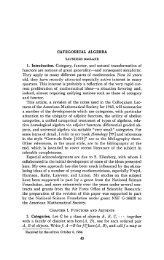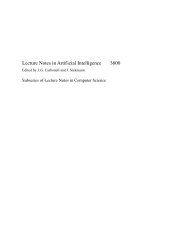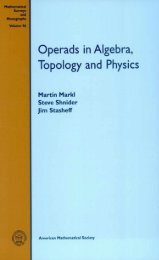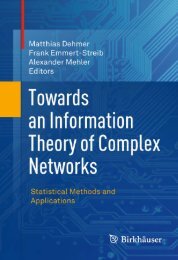Symmetric Monoidal Categories for Operads - Index of
Symmetric Monoidal Categories for Operads - Index of
Symmetric Monoidal Categories for Operads - Index of
You also want an ePaper? Increase the reach of your titles
YUMPU automatically turns print PDFs into web optimized ePapers that Google loves.
204 13 The (Co)homology <strong>of</strong> Algebras over <strong>Operads</strong><br />
coefficients <strong>for</strong> algebras in dg-modules is already defined in [26] by methods<br />
<strong>of</strong> homotopical algebra, the universal coefficient spectral sequences are defined<br />
in [1] <strong>for</strong> algebras in dg-modules (in the case <strong>of</strong> non-negatively graded dgmodules).<br />
Throughout this chapter, we use the short notation UP(A) =UP(A)(1) to<br />
refer to the enveloping algebra <strong>of</strong> P-algebras.<br />
13.1 The Construction<br />
The definition <strong>of</strong> the cohomology and homology <strong>of</strong> algebras over operads<br />
makes sense <strong>for</strong> operads and algebras in simplicial modules, or in dg-modules.<br />
In this section, we give a summary <strong>of</strong> the constructions in the dg-module<br />
setting. We take C =dgk Mod as a base category and E =dgk Mod as an<br />
underlying category <strong>of</strong> algebras. The principle <strong>of</strong> generalized point-tensors<br />
can be used to extend the construction to algebras in Σ∗-objects, and to<br />
algebras in right modules over operads.<br />
We fix an operad P. WerequirethatP is Σ∗-c<strong>of</strong>ibrant to ensure that Palgebras<br />
<strong>for</strong>m a semi-model category.<br />
13.1.1 Derivations and Cohomology. Recall that a map θ : A → E,<br />
where A is a P-algebra and E is a representation <strong>of</strong> A, <strong>for</strong>ms a derivation if<br />
we have the derivation relation<br />
n�<br />
θ(p(a1,...,an)) = p(a1,...,θ(ai),...,an)<br />
i=1<br />
<strong>for</strong> all operations p ∈ P(n) andalla1,...,an ∈ A. In the dg-context, we<br />
extend this definition to homogeneous maps θ : A → E to obtain a dg-module<br />
<strong>of</strong> derivations.<br />
The cohomology <strong>of</strong> A with coefficients in E is defined by:<br />
H ∗ P (A, E) =H ∗ (DerP(QA,E)),<br />
where QA is any c<strong>of</strong>ibrant replacement <strong>of</strong> A in the category <strong>of</strong> P-algebras. In<br />
∼<br />
this definition, we use the augmentation <strong>of</strong> the c<strong>of</strong>ibrant replacement QA −→<br />
A to equip E with the structure <strong>of</strong> a representation <strong>of</strong> QA.<br />
More generally, <strong>for</strong> any P-algebra B over A, we can use the restriction <strong>of</strong><br />
structures through the augmentation ɛ : B → A to equip E with the structure<br />
<strong>of</strong> a representation <strong>of</strong> B. Accordingly, we have a well-defined functor from<br />
the category <strong>of</strong> P-algebras over A to the category <strong>of</strong> dg-modules defined by<br />
the map DerP(−,E):B ↦→ DerP(B,E).<br />
The next proposition ensures that the definition <strong>of</strong> the cohomology makes<br />
sense:






